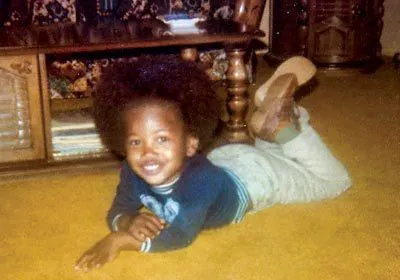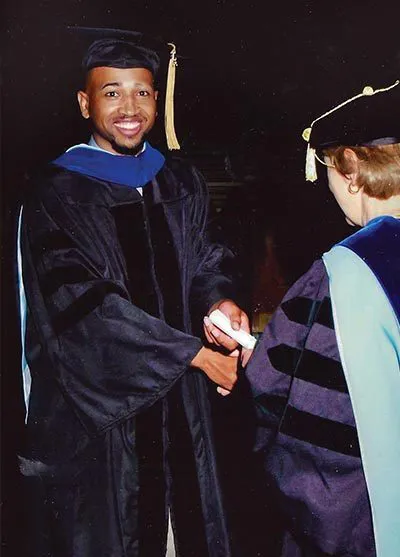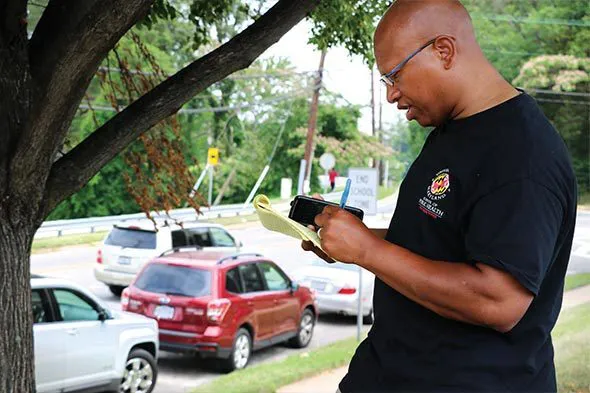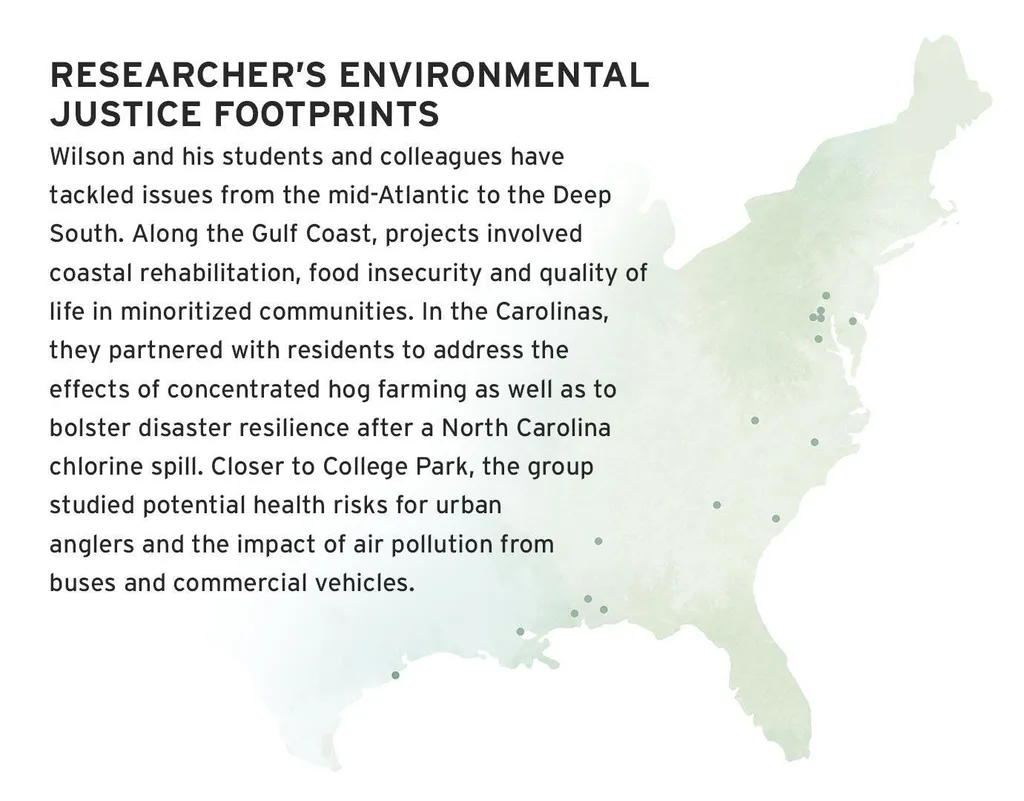- June 29, 2022
- By Liam Farrell
BORDERING A MAJOR East Coast port and braided with highways, Baltimore’s southern edge is a rushing two-way conduit for products constantly flowing in and the detritus of modern life continually flushing out. Much of this effluent is headed for the neighborhood of Curtis Bay, home to a trifecta of foul final destinations: a landfill, a medical waste facility and an animal rendering plant.
When Destiny Watford was growing up there more than a decade ago, adults urged her to get out as soon as possible. Brick rowhomes, churches, corner stores and school playgrounds share the air with a coal silo and fleets of diesel trucks, and Watford saw neighbors die of lung cancer and her mother struggle with asthma attacks.
The community already had some of the nation’s most polluted and deadly air, according to a collection of studies, when plans were announced in 2012 for a new trash incinerator—permitted to burn 4,000 tons a day and spew up to 1,240 pounds of lead and mercury annually—less than a mile from her high school. Anger overcoming her shy nature, then-16-year-old Watford co-founded an activist group and looked for allies in what became a four-year quest to stop it.
One important guide would be Sacoby Wilson, then an assistant professor in the University of Maryland’s School of Public Health. An expert on environmental toxins and the sociopolitical structures that make them so abundant where people of color live, Wilson helped the teenagers make contacts with legal and environmental groups and get their hands on the data they needed to mount a challenge to an international corporation.
“We weren’t lawyers or experts in any way, shape or form,” Watford says. “Sacoby ended up being one of those folks. He was really influential in making sure we had those connections.”
Now an associate professor with the Maryland Institute for Applied Environmental Health and Department of Epidemiology and Biostatistics, Wilson is at the forefront of investigating how the places where people live can determine their health. A proponent of community-based participatory research, he trains and assists people in getting the information they need to protect their families and homes. Wilson and his Center for Community Engagement, Environmental Justice and Health (CEEJH) have worked alongside overburdened and underserved people of color and low-wealth populations from Houston and New Orleans to Washington, D.C., aiming for the nexus of pollution, zoning and community development practices that disproportionately hurt vulnerable neighborhoods and reflect the ingrained biases of government and private industry actors.
By teaching people how to take water samples, read air monitor data from their homes and understand complex legal and regulatory structures, Wilson tries to do more than just document what happens to someone who lives near or works in a power plant or hog farm. Ultimately, as climate change intensifies and new threats like COVID-19 show how deadly historic health disparities can be, Wilson wants to help people “liberate themselves from the toxic trauma they are experiencing every day.”
“In working with people, you got to provide services,” he says. “(It’s) about solutions, about action, about mitigation, about investments.”

WILSON, WHO GREW up in Vicksburg, Miss., in the late 1970s and early 1980s, remembers some idyllic moments from his childhood, like trekking into the woods with friends to catch crawfish and pick wild blackberries—escapes he compares to scenes out of Mark Twain’s Southern tales.
But he also remembers the racism, especially when he played sports, as taunts and slurs rained down from not only spectators and opposing players but also coaches and referees. He wasn’t singled out just for his skin color, either; at age 7, he was diagnosed with alopecia, causing his hair to start falling out as his immune system attacked his follicles.
“Frightening, confusing, ostracizing—(it was) all those things,” Wilson says. “I went through all that stuff that kids go through when they are different.”
But his bright and precocious nature survived, says Bobbie Wilson, Sacoby’s mother. He spoke and read early in childhood, built his own lawnmower business and traveled 200 miles from home to board at an advanced science and math high school, full of determination and curiosity.
“He gave the teachers holy hell, as he would put it, because he was always trying to figure out this and figure out that,” Bobbie says. “He didn’t have any problem expressing himself. He is one of those people who would not stop talking.”
And he applied a burgeoning interest in biology and ecology to himself: What had made his body turn against itself? Was it bigotry? Or did his immune system rebel against toxins seeping in from the nearby highway, landfill, and concrete and sewer treatment plants?
Wilson has never been able to get clear answers to those questions, but a movement then gathering momentum would have said that they were worth asking.
The concept of “environmental justice” has antecedents in fights over working conditions during England’s Industrial Revolution and the horrors of early 20th century tenement housing in urban America, but it wasn’t until the 1960s civil rights movement that leaders like Martin Luther King Jr. began to draw clearer lines between who had to live and work in the most dangerous places and jobs and what it was doing to them.
In 1979, a group of Black homeowners in Houston filed a first-of-its-kind lawsuit alleging that building a landfill in their community, and within 1,500 feet of a public school, violated their civil rights. The challenge ultimately failed, but Robert Bullard, a sociologist and husband of the plaintiffs’ attorney and now known as the “father of environmental justice,” went about further documenting the city’s waste sites and their placement within African American neighborhoods.

The United Church of Christ Commission on Racial Justice provided the first national glimpse of the problem, releasing a 1987 report detailing how race was the most salient predictive factor for the location of industrial pollution sites, with three out of every five Black and Hispanic Americans living near uncontrolled toxic waste.
“These communities cannot afford the luxury of being primarily concerned about the quality of their environment when confronted by a plethora of pressing problems related to their day-to-day survival,” the report stated. “Within this context, racial and ethnic communities become particularly vulnerable to those who advocate the siting of a hazardous waste facility as an avenue for employment and economic development.”
So as Wilson headed off to Alabama A&M to earn his undergraduate degree in biology and ecotoxicology, followed by master’s and doctoral degrees in environmental health sciences from the University of North Carolina, the personal was melded with the scientific.
“He showed up. He would initiate things. He was enthusiastic. He had a great deal of knowledge,” says Victor Schoenbach, who was a professor in the UNC Department of Epidemiology and advised the Minority Student Caucus led by Wilson. “I have a hard time thinking of what he didn’t do.”

ABOUT 20 MILES northwest of Chapel Hill’s campus are the neighborhoods where Wilson says he got his “other Ph.D.” While his actual doctorate was based on research into industrial hog farming, the historically Black communities outside of Mebane, N.C., were where he learned how to listen to and partner with people on the ground.
Omega Wilson and his wife, Brenda, were living under nearby Mebane’s zoning and land-use control yet denied services like public water and sewer through a process known as “extraterritorial jurisdiction,” when they founded the West End Revitalization Association in 1994 to oppose a highway project and advocate for basic amenities.
“We were treated like the worst of the worst,” he says, “like we were no better than trash and sewage.”
The two Wilsons met at an environmental justice conference in 2000, bonding over shared Mississippi roots and then collaborating on a water quality study. They found not only water in the West End and other neighborhoods contaminated by feces and bacteria such as E. coli and Enterococci, but also failing pipes made of paper and tar. From conducting door-to-door surveys and training residents to take their own samples to the shocking results, Wilson says the partnership with Omega was his “real training working in a community.”
“That’s a big part of my foundation,” Wilson says. “You got parts of the country that aren’t in the 20th century, they are in the 19th century.”
That’s why Wilson focuses on what he calls “INpowerment”: Rather than just documenting problems and seeking academic understanding, he provides data and teaches the tools of academic inquiry directly to people affected by pollution so they have the knowledge necessary to take on a real fight for better health.
He’s applied that philosophy in a targeted manner, such as working with Millsboro, Del., residents for a July 2015 health assessment on a proposed poultry processing plant in an area already contaminated by dangerous chemicals like lead, chromium and arsenic. He’s also put it into practice more broadly through his center’s Maryland Environmental Justice Screen Tool. That allows anyone to pull up a map online and see how areas compare in pollution burdens like diesel particulates, proximity to treatment and disposal facilities, and watershed failures, while adding socioeconomic and contextual layers like education and income levels, supermarket locations and public transit stops. This way, Wilson says, money for green investment and mitigation in the state can be targeted to the communities that need it most.
Created in 2017 with colleagues from UMD and the Maryland Environmental Health Network, the map will be enhanced through a new $100,000 Environmental Protection Agency contract to add more rural issues such as pesticide exposure and proximity to large-scale animal feeding operations, in addition to children’s health markers like blood lead levels and maternal and infant mortality rates.
“This is the moment to seize on the fact that clean air is health care, and that climate justice and environmental justice also includes rural justice,” Ben Grumbles, Maryland secretary of the environment, said at a November event announcing the project.
The key to Wilson’s work, however, is not just his proficiency at
gathering and analyzing data, but also his personal investment. Omega
and his wife compare him to a “pastor in the pulpit,” and that passion
is evident whenever he speaks in public, whether addressing a group of
students at the University of California Irvine or giving a basic
definition of environmental justice on a Mississippi legislator’s radio show.
“It’s about where we live, where we work, where we play, where we pray, where we learn,” he says. “It’s proximal, it’s every day ... We’re talking about food, faith, family, health and jobs.”
With the backing of Wilson and the community’s research and advocacy, new sewer lines have been installed for more than 100 homes in the Mebane area.
“He lived with those disparities. He’s not just talking about them from an academic point of view,” Omega says. “It’s in his heart. You don’t see that very often.”

KAREN MOE DESCRIBES the smell that occasionally invades her house in Cheverly, Md., as similar to burning coffee—even though it’s definitely not from a Starbucks.
Sitting between the District of Columbia and College Park, portions of Cheverly are home to industrial operations like e-waste and scrap metal recycling, concrete manufacturing facilities, and emissions from commuters and delivery vehicles. Moe, who has lived there for 35 years, knows plenty of people suffering from asthma and respiratory problems.
“People wash cars and the next day, they can wipe the dust off of it,” she says.
So since last year, Moe has been one of about two dozen Cheverly residents helping to build a “hyperlocal” air quality monitoring network. CEEJH staff installed small, low-cost sensors on homes that draw in air with a fan and use a laser to measure particles, and provided training so residents can access and analyze real-time data posted online. Coupled with more Maryland Department of the Environment (MDE) inspections and warnings to local business about idling diesel trucks and errant dust, Moe says she is already feeling “more looked after” and hopes the information can be used to provide air quality warnings and show MDE where violations might be occurring.
“We can provide information that will help people who have sensitive conditions,” Moe says. “Give them guidance—don’t work outside today, limit your outdoor time.”
Environmental justice, Wilson says, requires long-term vision and support, and CEEJH is capable of that. Meta, the company formerly known as Facebook, recently made a $1.75 million gift to the center, supporting a new paid internship program, staff hires and its annual symposium.
“You’re trying to make up for 40, 50 years of stuff. It’s generational to even get incremental change,” he says. “That’s how insoluble, how deep, how entrenched these issues are.”
Wilson is an expert at preparing people for this “marathon,” says Omar Muhammad, the executive director of the North Charleston, S.C., LowCountry Alliance for Model Communities, which has partnered with Wilson for more than a decade on air pollution monitoring efforts, health disparity mapping and environmental health education.

“We’re learning the process of how zoning works, we’re learning the process of how to challenge a highway that’s being built in our communities,” Muhammad says. “When another project comes, we’re not challenged with these huge learning curves.”
For Destiny Watford, Wilson helped her learn that the disheartened assumptions she first heard from people in her neighborhood about the incinerator fight—“It’s too big,” “We’re poor,” “They are going to win”—did not, in fact, predict failure.
When the activists discovered that the Baltimore school system and other public agencies were planning to purchase energy from the incinerator, Wilson helped produce the research needed to protest and lobby the government to cancel its contracts. The incinerator’s permits eventually expired without construction in 2016; today, Watford, who won a global environmental prize for her efforts, works for Greenpeace in Colorado.
“It was fundamental—not only for my own development as a person, but for realizing that people have power,” she says. “Things aren’t set in stone. We can change things for the better.” TERP
This story is featured in the Spring 2022 issue of Terp magazine. Find all the stories online at terp.umd.edu.
Topics
PeopleUnits
School of Public Health